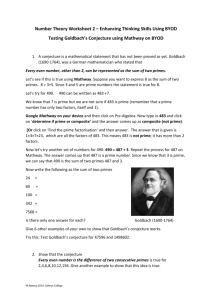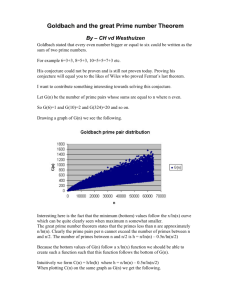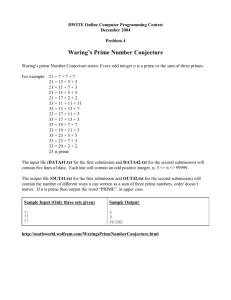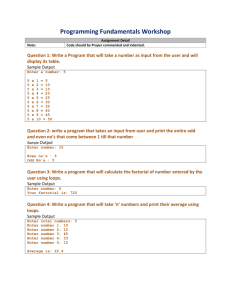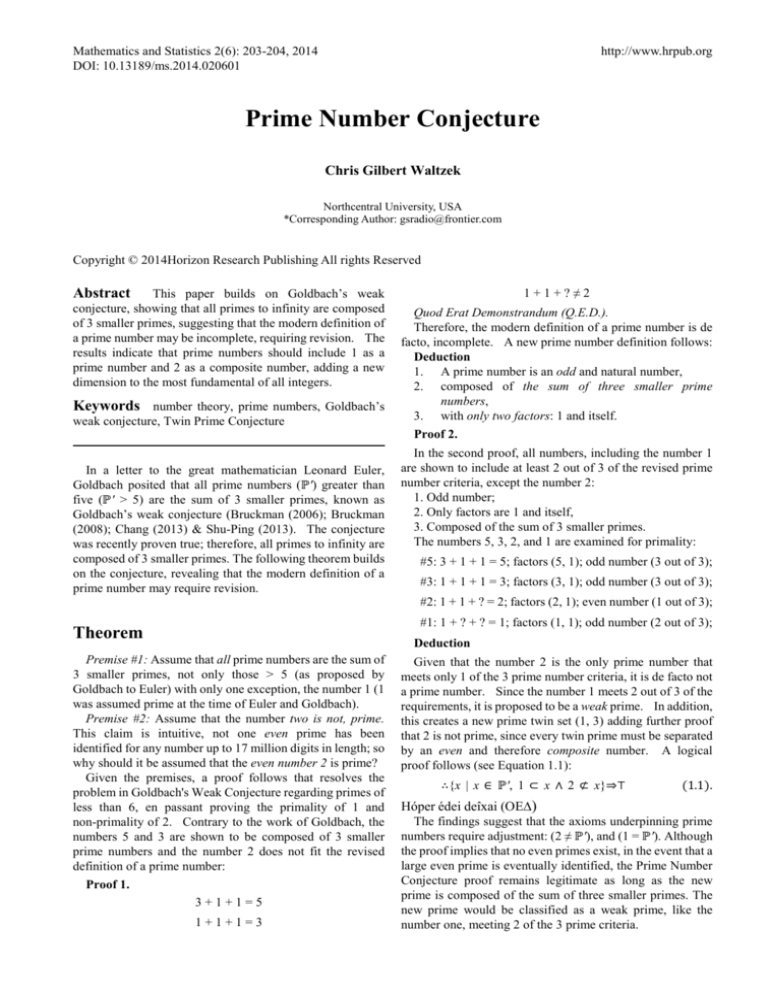
Mathematics and Statistics 2(6): 203-204, 2014
DOI: 10.13189/ms.2014.020601
http://www.hrpub.org
Prime Number Conjecture
Chris Gilbert Waltzek
Northcentral University, USA
*Corresponding Author: gsradio@frontier.com
Copyright © 2014Horizon Research Publishing All rights Reserved
Abstract This paper builds on Goldbach’s weak
conjecture, showing that all primes to infinity are composed
of 3 smaller primes, suggesting that the modern definition of
a prime number may be incomplete, requiring revision. The
results indicate that prime numbers should include 1 as a
prime number and 2 as a composite number, adding a new
dimension to the most fundamental of all integers.
Keywords number theory, prime numbers, Goldbach’s
weak conjecture, Twin Prime Conjecture
In a letter to the great mathematician Leonard Euler,
Goldbach posited that all prime numbers (ℙ′) greater than
five (ℙ′ > 5) are the sum of 3 smaller primes, known as
Goldbach’s weak conjecture (Bruckman (2006); Bruckman
(2008); Chang (2013) & Shu-Ping (2013). The conjecture
was recently proven true; therefore, all primes to infinity are
composed of 3 smaller primes. The following theorem builds
on the conjecture, revealing that the modern definition of a
prime number may require revision.
1+1+?≠2
Quod Erat Demonstrandum (Q.E.D.).
Therefore, the modern definition of a prime number is de
facto, incomplete. A new prime number definition follows:
Deduction
1. A prime number is an odd and natural number,
2. composed of the sum of three smaller prime
numbers,
3. with only two factors: 1 and itself.
Proof 2.
In the second proof, all numbers, including the number 1
are shown to include at least 2 out of 3 of the revised prime
number criteria, except the number 2:
1. Odd number;
2. Only factors are 1 and itself,
3. Composed of the sum of 3 smaller primes.
The numbers 5, 3, 2, and 1 are examined for primality:
#5: 3 + 1 + 1 = 5; factors (5, 1); odd number (3 out of 3);
#3: 1 + 1 + 1 = 3; factors (3, 1); odd number (3 out of 3);
#2: 1 + 1 + ? = 2; factors (2, 1); even number (1 out of 3);
#1: 1 + ? + ? = 1; factors (1, 1); odd number (2 out of 3);
Theorem
Premise #1: Assume that all prime numbers are the sum of
3 smaller primes, not only those > 5 (as proposed by
Goldbach to Euler) with only one exception, the number 1 (1
was assumed prime at the time of Euler and Goldbach).
Premise #2: Assume that the number two is not, prime.
This claim is intuitive, not one even prime has been
identified for any number up to 17 million digits in length; so
why should it be assumed that the even number 2 is prime?
Given the premises, a proof follows that resolves the
problem in Goldbach's Weak Conjecture regarding primes of
less than 6, en passant proving the primality of 1 and
non-primality of 2. Contrary to the work of Goldbach, the
numbers 5 and 3 are shown to be composed of 3 smaller
prime numbers and the number 2 does not fit the revised
definition of a prime number:
Proof 1.
3+1+1=5
1+1+1=3
Deduction
Given that the number 2 is the only prime number that
meets only 1 of the 3 prime number criteria, it is de facto not
a prime number. Since the number 1 meets 2 out of 3 of the
requirements, it is proposed to be a weak prime. In addition,
this creates a new prime twin set (1, 3) adding further proof
that 2 is not prime, since every twin prime must be separated
by an even and therefore composite number. A logical
proof follows (see Equation 1.1):
∴{x | x ∈ ℙ′, 1 ⊂ x ∧ 2 ⊄ x}⇒⊤
Hóper édei deîxai (OE∆)
(1.1).
The findings suggest that the axioms underpinning prime
numbers require adjustment: (2 ≠ ℙ′), and (1 = ℙ′). Although
the proof implies that no even primes exist, in the event that a
large even prime is eventually identified, the Prime Number
Conjecture proof remains legitimate as long as the new
prime is composed of the sum of three smaller primes. The
new prime would be classified as a weak prime, like the
number one, meeting 2 of the 3 prime criteria.
204
Prime Number Conjecture
New Twin Prime
Using the axioms underpinning the Prime Number
Conjecture, a new and unrecognized twin prime emerges:
Theorem
Given the Prime Number Conjecture and the twin prime
formula (n = ℙ′); n + 2 = twin ℙ′′), a previously unknown
twin number set includes 1 and 3:
Proof:
n = ℙ′; n + 2 = ℙ′′
1 = ℙ′; 1 + 2 = ℙ′′
1 = ℙ′; 1 + 2 = 3 = ℙ′′
Alternative Proof
1, 3 = ℙ′′
Given a specific, positive, even, and natural number, an
alternative proof yields similar results:
showing that all primes to infinity are composed of 3 smaller
primes, suggesting that the modern definition of a prime
number may be incomplete, requiring revision. The results
indicate that the axioms underpinning prime numbers should
include the number 1 as a prime number and the number 2 as
a non-prime number, adding a new dimension to the most
fundamental of all integers.
Acknowledgements
Special thanks to Professor Roger C. Tutterow (Mercer
University), a mentor and friend, for invaluable
encouragement and input on this and many other projects.
In addition, thank you to another mentor, Dr. Keshwani, for
his passion for teaching mathematics. Lastly, thanks to
NorthCentral University, for providing an astounding
learning format.
(2ℤ): n = 2ℤ; n +/- 1 = ℙ′′
2 + 1 = 3 = ℙ′
Deduction
2 - 1 = 1 = ℙ′
1, 3 = ℙ′′
Given the Prime Number Conjecture and the twin prime
formula, a previously undiscovered twin prime set emerges,
1, 3 = ℙ′′. The potential significance of this proof is in the
field of number theory, more specifically in the search for
proof or a counterexample to the Twin Prime Theory, for
which the Clay Mathematics Institute offers a $1,000,000,
Millennium Prize.
Discussion
This paper builds on Goldbach’s weak conjecture,
REFERENCES
[1]
Bruckman, P. S. (2006). A statistical argument for the weak
twin primes conjecture. International Journal Of
Mathematical Education In Science & Technology, 37(7),
838-842.
[2]
Bruckman, P. (2008). A proof of the strong Goldbach
conjecture. International Journal of Mathematical Education
In
Science
&
Technology,
39(8),
1102-1109.
doi:10.1080/00207390802136560
[3]
Chang, Y. C. (2013). Layman's method to verify Goldbach's
conjectures. World Journal of Engineering, 10(4): 401-404.
doi: 10.1260/1708-5284.10.4.401
[4]
Shu-Ping Sandie Han1, s. (2013). Additive number theory:
Classical problems and the structure of sumsets.
Mathematics & Computer Education, 47(1), 48-58




